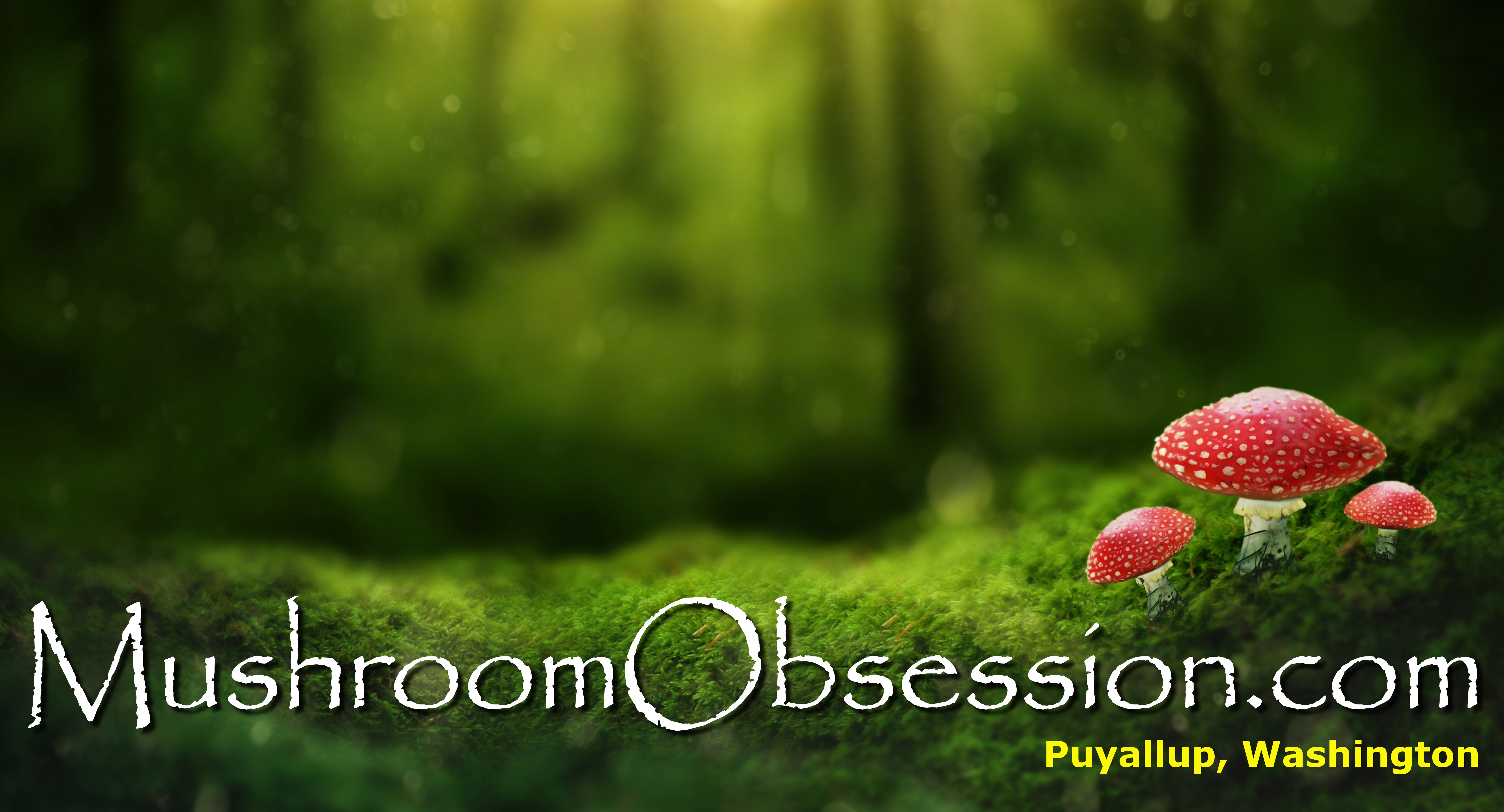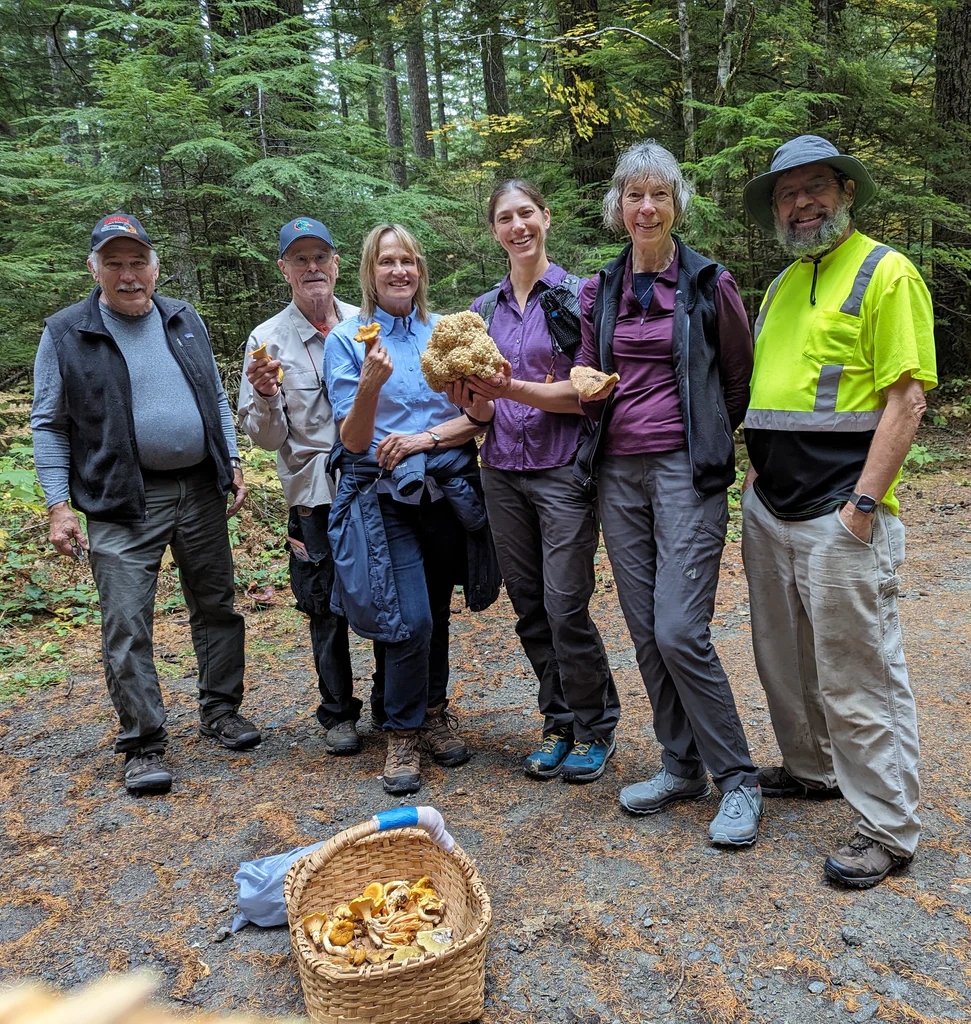Featured image: This great foray was organized by a former nursing colleague of my wife’s, named Diana (second from right), and we had a wonderful time. The group found one of two large Cauliflower Mushrooms discovered during October, quite a few Golden Chanterelles, Hedgehogs, and many other interesting mushrooms.
Our Fall 2023 mushroom forays in the Gifford Pinchot National Forest were spectacular. I wanted to show off some of the visitors we enjoyed, as well as the exotic mushrooms themselves.
A couple of high-level bullet points first:
- Due to a dry spring and summer, we were concerned about having a bust year like we did in 2022. However, thanks to some bountiful September/October rains and falling temps, our fears were mostly unfounded.
- The main thing we hunt for, Golden Chanterelles (Cantharellus), were still in relatively low supply, but at least there were some out there this year!
- Lobsters (Russula brevipes infected by the Hypomyces lactiflourum fungus) were plentiful in September and into October.
- Boletes — primarily Slippery Jacks (Suillus luteus) early on, then later Fat Jacks (Suillus americanus), Admirables (Aureoboletus mirabilis), and a few Kings (Boletus edulis) — were everywhere. Especially Admirables — in a typical year we find only one or two, but this year we found 30+ during a single foray! And some were enormous, with caps 8″ in diameter.
- Much to my personal delight, my favorite of all Fall mushrooms, the Hedgehog mushroom (Hydnum repandum) was back. I hadn’t seen these for the past four years, but last month found enough for several breakfasts’ worth.
- Lots of Angel Wings (Pleurocybella porrigens) this Fall. (I’ve harvested and eaten this for years and think it’s quite good, but as you’ll read on Wikipedia it has a storied history and so caution is advised.)
- In early abundance was the common puffball, Lycoperdon (which is Latin for “wolf fart” … they get their name from exuding clouds of brownish-green “spore smoke” when mature specimens are trod upon)
- Also coming on in large numbers was several species of coral or club fungus (Ramaria). Many are considered edible, though some cause digestive distress. (I’ve eaten them but don’t care for the flavor and texture. On recommendation, I’ve even pickled them. Yuk! Pickled mushrooms?)
- We found a number of other unusual mushrooms that we hadn’t seen any or much of during recent years, including …
- The excellent Cauliflower Mushroom (Sparassis)
- Pig’s Ears, also known as Violent Chanterelle (Gomphus clavatus)
- Fluted Black Elfin Saddle (Helvella lacunosa)
- Shaggy Mane, also known as Shaggy Ink Cap (Coprinus comatus)
- Shaggy Parasol (Chlorophyllum rhacodes)
Okay, now, here are the photos you have been waiting for. (While we enjoyed about two dozen foray guests during October, not all are depicted.)

This group of foragers hit the jackpot with more than 30 Admirable Boletes collected, some as large as 8″ in diameter!

Eli proudly displays his first find of a nice Golden Chanterelle.

Early Golden Chanterelles (this one from September) are lighter in color than their more later counterparts.

My long-time hunting companion and beloved son Nathan shows off our first (of many) Admirable Bolete.

Above is the gill view of one of several Pig’s Ears mushrooms we found, and below is the view from above the cap, which more closely resembles the name “Pig’s Ears.”


Despite a particularly rainy day in the rainforest, a foray participant (right) shows off a nice Golden Chanterelle, while I hoist a medium-sized Admirable Bolete.

More Admirable Boletes, in situ. These always grow out of decaying wood. Some don’t care for the flavor, which is somewhat lemony, but I like the savory nature of the mushroom. And they can grow as large as 8″ diameter caps.

Here’s a nice large Admirable Bolete procured by one of our foray participants.

Speaking of large, here is one of two wonderfully edible and choice Cauliflower Mushrooms we harvested. These reportably infest one out of every 1,000 dying fir trees! And frequently return in subsequent years.

Here are some other favorite finds: Clockwise from upper left, a Shaggy Parasol, two large Shaggy Manes, and a collection of my Fall favorite, the Hedgehog Mushroom.

In this photo, the unusual (particularly unusually textured, almost like soft rubber) mushroom on top is a white Toothed Jelly Mushroom (Pseudohydnum gelatinosum, subspecies pusillum), compared to the gill side of a single Angel Wing below it.

This shows Angel Wings in situ. They always appear brilliantly in dead and down fir trees.

Our research associate, Dr. Dave Lingenfelter, displays a nice Lobster. (In the background is our new basecamp rig, an all-solar GoSun Camp365.)

This Lobster mushroom announces its presence as it pops out of the humus.

The results of a final research foray in early October convinces me that we are ready to start hosting regular forays for our public. Results includes a large Lobster at upper left, and also small puffballs and coral mushrooms front and center. Lots of Slippery Jacks upper right, and Golden Chanterelles below them. At far left are some unusual polypores set aside for research purposes.
While we found many edibles, we had as usual to weed out some inedibles, including …

Amanita muscaria, or Fly Agaric. As these contain psychoactive compounds, they are technically considered toxic, although some seek them for enjoyment of their effects. Personally, I boil off the water-soluble toxins and enjoy the remaining mushroom flesh, which is edible. Photo courtesy of first-nature.com.

Lots of False Chanterelles out there right now. The caps look similar from above, but the gill structure and dark, flimsy stipes will give them away. (The insides of true Golden Chanterelle stipes are firm and white.) I’ve eaten one of these falsies (by accident, in a batch of true chanterelles) once and regretted it for a day or two.

Worse by far are the pretty but highly toxic Amanitas which are springing up in everyone’s lawns right now. I’m not 100% certain but believe this sample to be Amanita smithiana, which will make you quite sick with kidney failure. Eating even one of certain Amanitas can be deadly, which is why we practice 100% positive identification.

On the up side, hunting and eating exotic edible mushrooms is a fun and healthful pasttime, and one that helps you to learn and appreciate the amazing world around us. And sometimes, you can even use mushrooms for holiday decorations, as this student at one of the schools we work at showed us!
Happy Halloween, and happy hunting!
HALLOWEEN RESEARCH FORAY UPDATE:

In follow-up, here are results from my Halloween research foray. It’s clear many mushrooms have survived the recent frosts, although edible varieties are decreasing in quantity.
Clockwise from top left: Miscellaneous boletes, probably Fat Jacks; one medium-sized Admirable Bolete; Angel Wings; a Fluted Black Elfin Saddle (I ate that this morning for breakfast and it was delicious!); a nice collection of Hedgehogs (my favorite Fall mushroom, and tomorrow morning’s breakfast); a few remaining decent Lobsters; a Fly Agaric (center, orange-ish red with white spots); and quite a few decent (though nearing the end of their lifespan) Golden Chanterelles.
Are you a shroomophile?
Sign up for the latest from the fantastic world of fungi!Subscribe
Learn more about Mushroom Obsession …
© 2024 MushroomObsession.com


Leave a comment